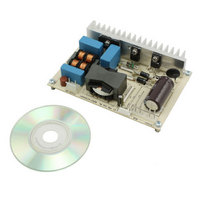EVL6563S-250W STMicroelectronics, EVL6563S-250W Datasheet - Page 28

EVL6563S-250W
Manufacturer Part Number
EVL6563S-250W
Description
EVAL BOARD FOR L6563(250W)
Manufacturer
STMicroelectronics
Type
Power Factor Correctionr
Specifications of EVL6563S-250W
Main Purpose
Power Management, Power Factor Correction
Embedded
No
Utilized Ic / Part
L6563
Primary Attributes
250W Power Factor Correction and Preregulator Combination
Secondary Attributes
Transition Mode & Active Tracking Boost Function.
Board Size
88 mm x 116 mm
Maximum Operating Temperature
+ 50 C
Operating Supply Voltage
90 V to 265 V
Product
Power Management Modules
Dimensions
88 mm x 116 mm
Lead Free Status / RoHS Status
Lead free / RoHS Compliant
For Use With/related Products
L6563S
Other names
497-10489
Available stocks
Company
Part Number
Manufacturer
Quantity
Price
EMI filtering and conducted EMI pre-compliance measurements
7
28/32
Figure 40. EVL6563S-250W CE AVG
EMI filtering and conducted EMI pre-compliance
measurements
Figures 40, 41, 42, and
at full load and nominal mains voltages for both mains lines. The limits shown in the
diagrams are EN55022 class-B which is the most popular standard for domestic equipment
using a two-wire mains connection.
It is worth remembering that typically a PFC produces a significant differential mode noise
with respect to other topologies. In case an additional margin, with respect to the limits, is
needed, increasing the differential attenuation by increasing the across the line (X)
capacitors or theC4 capacitor after the rectifier bridge is suggested. Sometimes a differential
mode coil connected as a pi-filter placed after, between the bridge rectifier and the boost
stage, is more effective and cheaper than increasing the size of the common mode filter coil
which would filter the differential mode noise by the leakage inductance only between the
two windings.
To recognize if the circuit is affected by common mode or differential mode noise it is
sufficient to compare the spectrum of phase and neutral line measurements; if the two
measurements are very similar the noise is almost totally common mode. If there is a
significant difference between the two measurement spectrums, their difference represents
the amount of differential mode noise. Of course to get a reliable comparison the two
measurements have to be done under the same conditions.
Because the differential mode produces common mode noise through the magnetic field
induced by the current, decreasing the differential mode consequently limits the latter.
As visible in the diagrams, in all test conditions there is at least a 6dB margin of the
measurements with respect to the limits. The measurements have been done in AVG
detection to evaluate the benefit of the jittering effect of the TM control.
measurement at 115 Vac-60 Hz - full
load - phase wire
43
show the measurement in average mode of the conducted noise
Doc ID 16849 Rev 2
Figure 41. EVL6563S-250W CE AVG
measurement at 115 Vac-60 Hz - full
load - neutral wire
AN3119
















